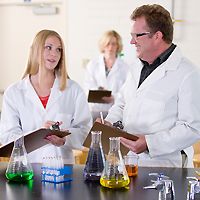My Cart
Your Shopping Cart is currently empty. Use Quick Order or Search to quickly add items to your order!
 It is vital that you maintain a well-managed classroom and student laboratory. Before students return in the fall, take steps to ensure a successful, mishap-free year of science teaching. We suggest beginning your school term with a thorough examination of your laboratory work and storage areas.
It is vital that you maintain a well-managed classroom and student laboratory. Before students return in the fall, take steps to ensure a successful, mishap-free year of science teaching. We suggest beginning your school term with a thorough examination of your laboratory work and storage areas.
Teachers and teacher-aides should lead by example and wear personal protective equipment (PPE); follow and enforce safety rules, procedures, and practices; and demonstrate safety behavior and promote a culture of safety. They should be proactive in every aspect of laboratory safety, making safety a priority.
This general safety checklist highlights essential information for working in the high school laboratory. It should be periodically reevaluated for updates.
Remind students of the importance of PPE with these videos
If you will be performing dissections, review these FAQs about Dissection Safety .
Examples of lab safety agreements can be found at these links:
This information is from the School Chemistry Laboratory Safety Guide created by the U.S. Consumer Safety Product Commission (CPSC), Department of Health and Human Services, Centers for Disease Control and Prevention (CDC), and the National Institute for Occupational Safety and Health (NIOSH).
Your responsibilities for lab safety continue through to the end of the school year. Properly disposing of chemicals, preserved organisms, and other lab wastes should be included in your end of the year procedures. The end of the year is also a good time to review safety equipment and supplies that were used during the year to determine if replacements are needed. Learn more about closing up the lab .
Carolina offers an extensive line of chemicals, chemistry sets, lab safety products and equipment.